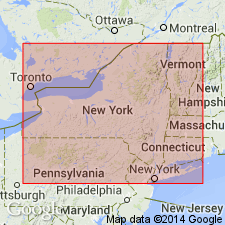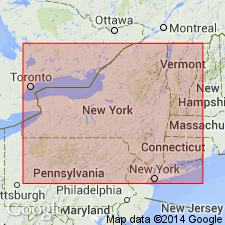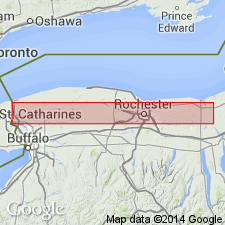
- Usage in publication:
-
- Glenmark Member
- Modifications:
-
- Named
- Dominant lithology:
-
- Limestone
- AAPG geologic province:
-
- Appalachian basin
Summary:
The Glenmark Member of the Rochester Shale is here named in Wayne and Cayuga Cos., NY. It is a distinctive, ledge-forming unit in the middle part of the Rochester and consists of dark bluish-gray, argillaceous limestone with thin shaly partings. The base of the Member contains coarsely crystalline limestone with hematite stringers. The lower contact with the calcareous lower part of the Rochester is gradational; the upper contact with the upper Rochester is abrupt and sharp. Thickness is 9 m (30 ft) at type locality. Age is Middle Silurian (Wenlockian).
Source: GNU records (USGS DDS-6; Reston GNULEX).

- Usage in publication:
-
- Glenmark Formation, Shale
- Modifications:
-
- Revised
- AAPG geologic province:
-
- Appalachian basin
Summary:
The Rochester Shale in eastern NY (Wayne Co.) is capped by a distinctive 40-cm-thick dolomitic limestone bed containing small favositid, rugose corals, and the distinctive brachiopod NUCLEOSPIRA. This bed marks the approximate position of the DeCew Dolostone of western NY and together with the overlying shales is herein referred to as the Glenmark Formation. Identification of this unit in Wayne Co. confirms that the sharp, erosional contact between the DeCew and Gasport Formations in the Niagara region is a low angle unconformity. The interval is an important marker that is traceable from this area southward through much of the central PA Appalachians and into MD and WV. Previously treated simply as upper portion of Rochester. In Sodus Creek, Glenmark is 3 m thick and is overlain by the Sconondoa Formation, the lateral equivalent of the lower part of the Lockport Group of western NY. Unit is shown in fig. 17 as Glenmark Shale, the uppermost unit of Sequence V and the uppermost unit of the Clinton Group. Age is Early Silurian (Wenlockian).
Source: GNU records (USGS DDS-6; Reston GNULEX).

- Usage in publication:
-
- Glenmark Bed
- Modifications:
-
- Revised
- AAPG geologic province:
-
- Appalachian basin
Summary:
An argillaceous, resistant limestone bed herein referred to as the Glenmark Bed overlies the Rochester Shale in the Sodus area of western NY. The Glenmark occurs at the base of the DeCew Formation according to the figure, and not within the Rochester as originally defined. [This stratigraphic position does not agree with that described in the naming paper, which clearly states that the Glenmark lies in the middle of the Rochester between two unnamed shales.]
Source: GNU records (USGS DDS-6; Reston GNULEX).
For more information, please contact Nancy Stamm, Geologic Names Committee Secretary.
Asterisk (*) indicates published by U.S. Geological Survey authors.
"No current usage" (†) implies that a name has been abandoned or has fallen into disuse. Former usage and, if known, replacement name given in parentheses ( ).
Slash (/) indicates name conflicts with nomenclatural guidelines (CSN, 1933; ACSN, 1961, 1970; NACSN, 1983, 2005, 2021). May be explained within brackets ([ ]).

